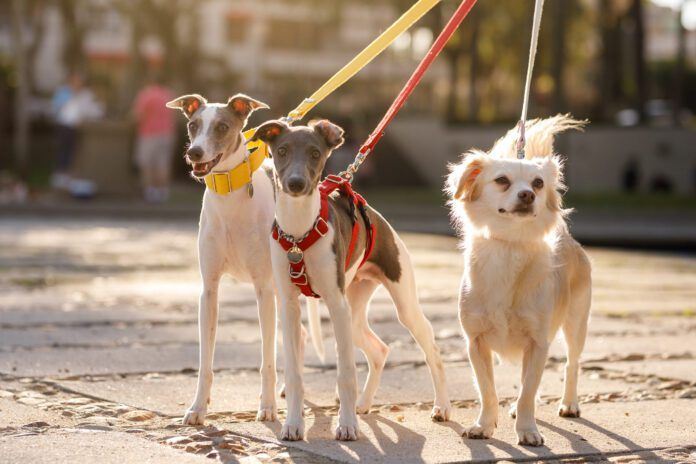There are so many dogs collars and harnesses to choose from, and so much conflicting information comparing a dog collar vs harnesses! How do you know which is best for your puppy – or your adult dog? While the answer is “it depends,” here are some guidelines to help you choose the best gear for your canine companion.
Dog Collars vs Harnesses: Gear to dismiss from consideration
The easiest part of selecting collars or harnesses is determining which ones to dismiss. We disqualify from consideration any equipment that’s designed to cause pain or discomfort to your dog. This includes shock collars (marketed euphemistically as “e-collars”), prong and choke collars, and “no-pull” harnesses that tighten around your dog’s barrel. Don’t let anyone tell you that these aren’t aversive. They are; that’s how they control the dog, through pain.
We prefer to teach dogs how to behave on leash, rather than just inflict discomfort in order to suppress their pulling or other unwanted behavior.
Next, we recommend rejecting any equipment that your dog finds aversive, even if it isn’t designed or intended to be. If you use gear that your dog clearly hates, it will be difficult for her to happily learn and cooperate with you.

There are some products that most dogs dislike when initially introduced, such as head halters. Most dogs require a very slow, tactful introduction and considerable conditioning to regard these products as acceptable – and many owners find the counter-conditioning and desensitization process required to get their dogs to accept head halters (in particular) to be excruciatingly slow going. If your dog shows she hates her head halter, I’d recommend setting it aside.
Vibration collars are often marketed as aversive, but if you build a positive association for your dog with the vibration from the start, it can be used in a positive way. Owners of deaf dogs often use vibration collars to signal or cue their dogs for various behaviors, but a dog doesn’t have to be deaf for the collar to be used in this way. But again, if your dog shows you that she finds the vibration aversive, despite your efforts to counter-condition and desensitize her to it, it’s a no-go. (See “Vibration Collars: What You Should Know,” WDJ November 2019, for more information about using vibration collars in a positive way for cuing your dog.)
Most dogs are happy with a regular harness, and these are generally considered to be non-aversive. However, if your dog runs away from you when you pick up her harness she’s telling you she hates it; cross it off your list!
Gear we like

Every collar or harness has the potential to be aversive if improperly used, so even our approved training tools should be used correctly – no yanking, jerking, or hanging, please! In general, our favorite gear for walking dogs includes:
Generally, flat collars, properly fitted martingale collars, and front-and/or back-clip harnesses are our first tools of choice.
For dogs who don’t pull, flat collars and back-clip harnesses are perfect.
If your dog has learned to back out of her collar, martingale collars can be a lifesaver. Sometimes called “Greyhound collars,” martingale collars are ideal for dogs with very narrow skulls, as well as thick-necked dogs whose heads are smaller than their necks. These “limited slip” collars tighten with leash tension, but only to a certain point – just enough to prevent them from slipping over the dog’s head.

For dogs who pull, we like the newer generation of front-clip harnesses. These products don’t have straps that go across the shoulder and impede the dog’s movement. See “The Best Front Clip Harnesses,” April 2017, for our favorites. We find head halters and vibration collars to be acceptable for dogs who are comfortable with them.
We recommend breakaway collars for dogs who play and wrestle with a lot of mouth-to-neck biting. Alternatively, remove your dogs’ collars before they play – or when you leave them together unsupervised – to prevent potentially deadly choking accidents.
Choosing a collar for puppies requires the utmost of care. It should be obvious that aversive tools are off the table, but even flat collars have potential to significantly damage baby-soft tracheas if you have a puppy who pulls. Be extra careful with your baby dog to be sure you aren’t putting pressure on that tender throat; a harness is generally a better choice.
You Choose
There is no pat answer to the collar/harness question. Review the options, get some help (if needed) with the fit of the product you choose, watch to see how your dog responds to your choice – and make changes accordingly. And remember to train your dog, so pulling becomes less of an issue regardless of what equipment you choose. (See “Polite Leash Walking,” September 2021, and “No Need for Force: How to Stop Your Dog From Pulling on the Leash,” April 2022.)







Hi! Another safety consideration is important in case the dog’s collar gets caught on something (including another dog’s jaw, a fence, tree branch, etc). To undo a collar that has a buckle, you first have to tighten it. A collar with a clip can be released by squeezing the sides of the clip, often with one hand, and can be released without tightening.